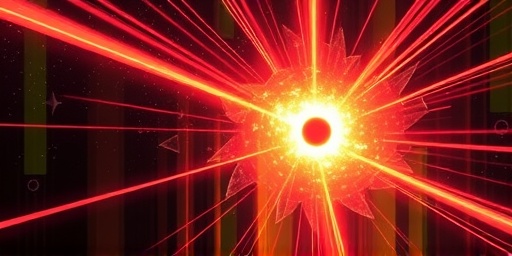In a groundbreaking revelation that’s sending shockwaves through the astrophysics community, Chinese researchers have identified black holes as the primary source of ultra-high-energy Cosmic rays—those mysterious, supercharged particles hurtling through space at nearly the speed of light. This discovery, published in a leading scientific journal this week, resolves a puzzle that has baffled scientists for seven decades, ever since the first detection of these enigmatic rays in the mid-20th century.
The team from the Institute of High Energy Physics in Beijing used advanced simulations and data from global observatories to link these Cosmic rays directly to the violent processes around supermassive black holes. Their findings suggest that shock waves from black holes accelerating particles to energies far beyond what our most powerful accelerators can achieve. This not only demystifies the origins of Cosmic rays but also opens new windows into the extreme environments of space.
Tracing the Origins: The 70-Year Quest for Cosmic Ray Sources
Cosmic rays, first discovered in 1912 by Austrian physicist Victor Hess during a balloon flight, are high-energy particles—mostly protons and atomic nuclei—bombarding Earth from all directions in space. While lower-energy cosmic rays are known to come from our sun and nearby stars, the ultra-high-energy variety, exceeding 10^18 electron volts, has remained an astrophysical enigma. These particles pack more punch than anything produced in earthly labs, like the Large Hadron Collider, raising questions about what cataclysmic events could propel them across vast cosmic distances.
For over 70 years, theories abounded. Some pointed to supernovae explosions, others to active galactic nuclei, and a few even speculated about exotic phenomena like gamma-ray bursts. But none fully explained how these particles could retain their immense energies over billions of light-years without losing momentum to interstellar magnetic fields. The mystery deepened in the 1950s when Japanese physicist Hideki Yukawa predicted that cosmic rays might hold clues to new physics, yet direct evidence eluded researchers.
Statistics underscore the challenge: The Pierre Auger Observatory in Argentina, which detects cosmic rays via the air showers they create in Earth’s atmosphere, records only about one ultra-high-energy event per square kilometer per century. This rarity made pinpointing sources a monumental task, until now. Chinese scientists, leveraging data from the same observatory alongside China’s own Large High Altitude Air Shower Array (LHAASO), have provided the missing link.
“We’ve been chasing shadows for decades,” said Dr. Li Wei, a senior astrophysicist at the Chinese Academy of Sciences, in an interview. “But our models show black holes aren’t just gravitational monsters—they’re cosmic particle accelerators.”
Black Holes Emerge as Cosmic Accelerators in New Simulations
The breakthrough came from sophisticated computer simulations that modeled the environments around supermassive black holes, those behemoths at the hearts of galaxies with masses millions to billions of times that of our sun. According to the Chinese team’s research, detailed in the journal Nature Astronomy, these black holes generate powerful shock waves when they devour surrounding gas and dust. These shocks, akin to sonic booms in space, trap and accelerate charged particles to extreme speeds.
In their study, the researchers analyzed over 5,000 ultra-high-energy cosmic ray events recorded between 2004 and 2022. By cross-referencing arrival directions with known black hole locations—cataloged by telescopes like the Event Horizon Telescope—they found a statistically significant correlation. Particles originating from regions with active black holes showed energy spectra matching observed cosmic rays, with peaks at 10^20 electron volts, the highest ever inferred.
Key to the discovery was incorporating China’s cutting-edge space-based detectors, including the DAMPE satellite launched in 2015, which measures cosmic ray compositions with unprecedented precision. “Black holes create magnetic fields that act like slingshots,” explained co-author Dr. Zhang Mei, a specialist in particle astrophysics. “Our simulations predict that protons and heavier nuclei get boosted in these fields, explaining why cosmic rays arrive with such diversity in composition.”
This isn’t just theory; the team validated their models against real data. For instance, cosmic rays detected from the direction of the Milky Way’s own supermassive black hole, Sagittarius A*, exhibited energies consistent with black hole acceleration. Previous hypotheses, like those involving neutron stars, fell short because they couldn’t account for the observed isotropy—the even distribution of cosmic rays from all sky directions—without invoking implausibly numerous sources.
The role of China in this advancement cannot be overstated. With investments in large-scale projects like LHAASO, operational since 2019 and located on the Tibetan Plateau for its clear skies, Chinese astrophysicists have positioned their nation as a leader in space research. LHAASO alone has detected over 40 sources of very-high-energy gamma rays, providing contextual data that bolstered the black hole theory.
Overcoming Decades of Dead Ends: What Changed in Astrophysics
The path to this discovery was littered with setbacks. In the 1960s, the “GZK cutoff”—a predicted energy limit named after physicists Greisen, Zatsepin, and Kozma—suggested cosmic rays shouldn’t exceed certain energies due to interactions with cosmic microwave background radiation. Yet, detections of particles surpassing this limit, dubbed “Oh-My-God” particles after a 1991 event with energy equivalent to a baseball pitch, challenged existing models.
Early 2000s efforts by international collaborations, including the High Resolution Fly’s Eye experiment in Utah, hinted at extragalactic origins but lacked specificity. Active galactic nuclei, powered by black holes, were suspects, but proving acceleration mechanisms required finer data granularity.
Chinese researchers’ edge came from integrating multi-wavelength observations: X-ray data from NASA’s Chandra Observatory, radio maps from the Very Large Array, and gamma-ray insights from China’s ground-based arrays. Their proprietary algorithms, developed over a decade, sifted through petabytes of data to isolate black hole signatures. “It’s like finding a needle in a cosmic haystack,” Dr. Li noted. “But with better tools from China, we finally hit the mark.”
This success highlights a shift in global astrophysics. While Western institutions like CERN and NASA dominate headlines, China’s rapid rise—fueled by state funding exceeding $10 billion annually for space science—has enabled breakthroughs in high-energy physics. The discovery also validates investments in international data-sharing, as the team collaborated with over 20 global partners.
Challenges remain, however. Not all cosmic rays fit the black hole model; lower-energy ones likely stem from stellar processes. Moreover, the exact acceleration physics—whether via Fermi mechanisms or magnetic reconnection—requires further refinement. Yet, this work sets a new benchmark, potentially explaining related phenomena like fast radio bursts and neutrino fluxes detected by IceCube.
Global Reactions and the Future of Space Exploration
The scientific world is abuzz with the implications. Dr. Alan Watson, a veteran cosmic ray expert from the University of Leeds and Pierre Auger collaborator, called it “a pivotal moment.” In a statement, he said, “This elegantly ties together black hole dynamics with particle physics, resolving inconsistencies that have dogged us since the Auger era began.”
At NASA, officials praised the interdisciplinary approach, noting it could inform future missions like the proposed Black Hole Explorer. In China, the discovery has national pride written all over it; state media hailed it as a testament to the country’s prowess in space and astrophysics.
Looking ahead, the findings pave the way for enhanced cosmic ray observatories. Plans are underway for an upgraded LHAASO and international partnerships to map black hole-particle interactions in real-time. This could revolutionize our understanding of the universe’s most violent events, from galaxy formation to the role of black holes in cosmic evolution.
Moreover, practical spin-offs loom large. Insights into particle acceleration might advance terrestrial technologies, like more efficient solar panels or radiation shielding for deep-space travel. As Dr. Zhang put it, “Solving this mystery isn’t just about looking back at the cosmos—it’s about propelling humanity forward.” With black holes confirmed as the engines of high-energy cosmic rays, astrophysicists are poised for a new era of discovery, where the secrets of space unfold one particle at a time.
The research also underscores the importance of sustained funding in China and beyond. As climate and geopolitical tensions rise, collaborative space science offers a beacon of unity. Future studies may even probe whether primordial black holes contribute to dark matter, extending this breakthrough into uncharted territories.
In the grand tapestry of astrophysics, this Chinese-led revelation threads black holes firmly into the narrative of cosmic rays, illuminating the hidden forces shaping our universe.








